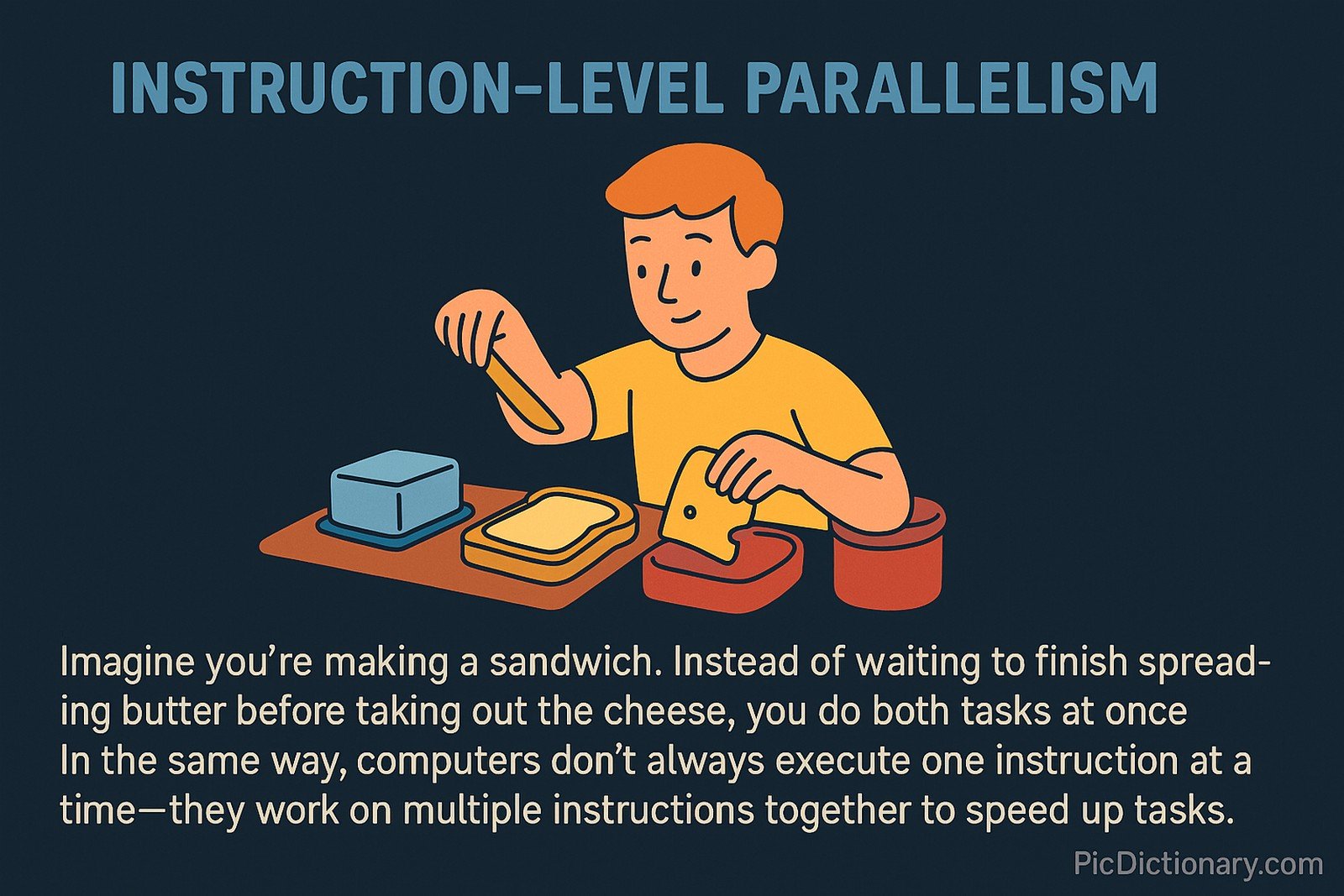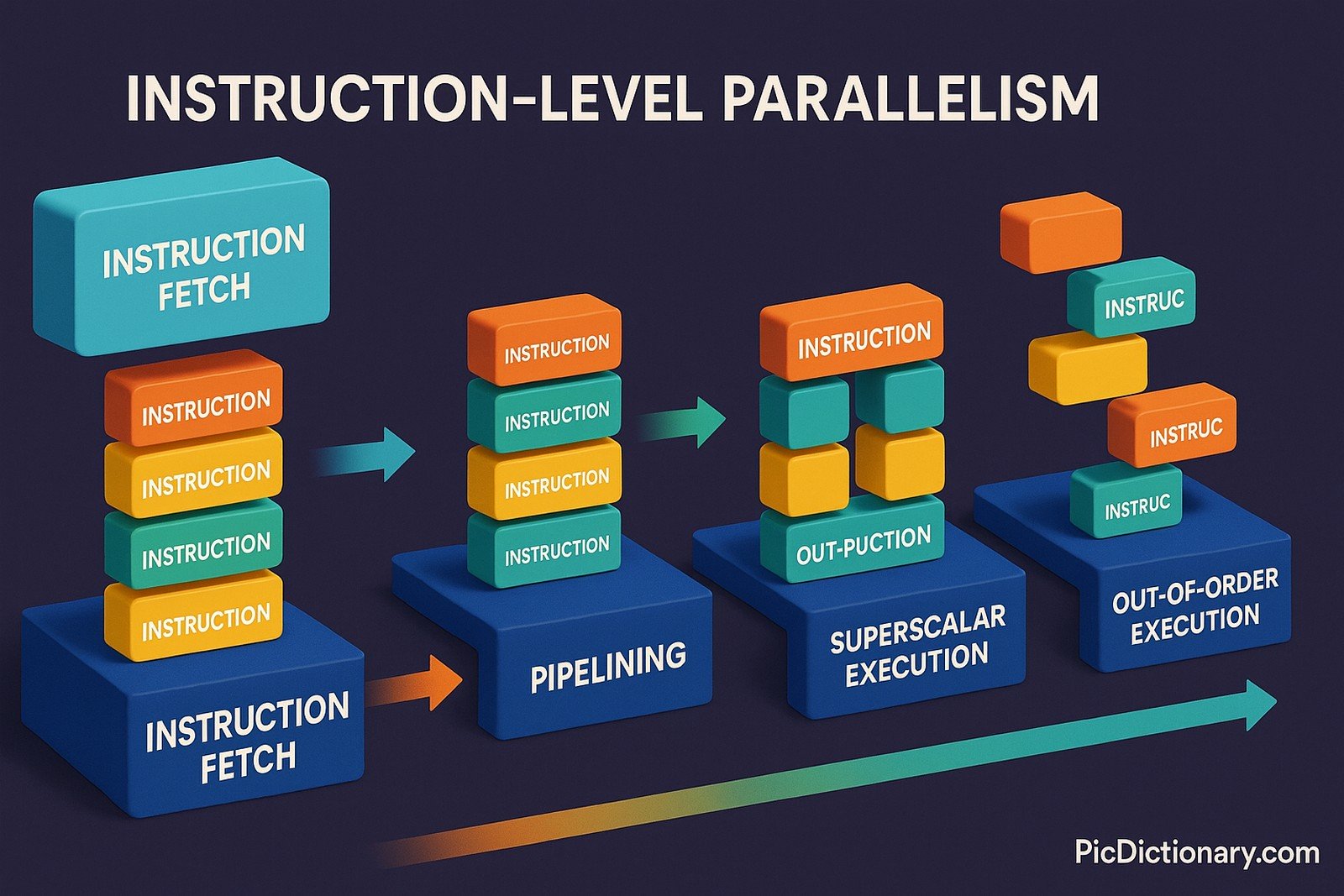Instruction-Level Parallelism

Quick Navigation:
- Instruction-Level Parallelism Definition
- Instruction-Level Parallelism Explained Easy
- Instruction-Level Parallelism Origin
- Instruction-Level Parallelism Etymology
- Instruction-Level Parallelism Usage Trends
- Instruction-Level Parallelism Usage
- Instruction-Level Parallelism Examples in Context
- Instruction-Level Parallelism FAQ
- Instruction-Level Parallelism Related Words
Instruction-Level Parallelism Definition
Instruction-Level Parallelism (ILP) is a computer architecture technique that allows multiple instructions to be executed simultaneously within a single processor cycle. This is achieved through mechanisms like pipelining, superscalar execution, out-of-order execution, and register renaming. ILP optimizes CPU performance by overlapping instruction execution stages, reducing idle time and improving throughput.
Instruction-Level Parallelism Explained Easy
Imagine you're making a sandwich. Instead of waiting to finish spreading butter before taking out the cheese, you do both tasks at once. In the same way, computers don’t always execute one instruction at a time—they work on multiple instructions together to speed up tasks.
Instruction-Level Parallelism Origin
ILP has its roots in early CPU architecture design. The concept became more prominent in the 1980s when researchers developed techniques like pipelining and superscalar execution to enhance processing speeds.
Instruction-Level Parallelism Etymology
The term derives from “instruction,” meaning a command given to a processor, and “parallelism,” which refers to executing multiple operations at the same time.
Instruction-Level Parallelism Usage Trends
With the rise of modern CPUs, ILP techniques have evolved significantly. Advanced processors use speculative execution and branch prediction to increase ILP. However, as the industry moves towards multi-core processors, thread-level parallelism (TLP) is gaining more emphasis.
Instruction-Level Parallelism Usage
- Formal/Technical Tagging:
- Computer Architecture
- CPU Optimization
- High-Performance Computing - Typical Collocations:
- "ILP optimization"
- "superscalar execution"
- "instruction pipeline"
- "parallel execution of instructions"
Instruction-Level Parallelism Examples in Context
- A modern CPU executes multiple instructions at once using out-of-order execution.
- High-performance processors leverage ILP to speed up gaming and video processing.
- Superscalar architectures utilize ILP to process data faster than scalar architectures.
Instruction-Level Parallelism FAQ
- What is instruction-level parallelism?
Instruction-Level Parallelism (ILP) is the ability of a processor to execute multiple instructions simultaneously within a single clock cycle. - How does ILP improve CPU performance?
By overlapping instruction execution stages, ILP reduces idle time, making CPUs faster and more efficient. - What are the main techniques used in ILP?
Common techniques include pipelining, superscalar execution, out-of-order execution, branch prediction, and register renaming. - What is the difference between ILP and TLP?
ILP focuses on executing multiple instructions from the same thread, while Thread-Level Parallelism (TLP) executes multiple threads simultaneously. - Why is pipelining important for ILP?
Pipelining breaks instruction execution into stages, allowing different instructions to be processed at different stages simultaneously. - What are the limitations of ILP?
ILP is limited by data dependencies, control dependencies, and hardware constraints, which can reduce parallel execution efficiency. - What is superscalar execution?
Superscalar execution enables a CPU to issue multiple instructions per clock cycle using multiple execution units. - How do modern CPUs maximize ILP?
Modern CPUs use speculative execution, dynamic scheduling, and register renaming to improve ILP performance. - Does ILP benefit all types of software?
ILP is most beneficial for computational-heavy tasks but may not significantly improve performance for highly sequential programs. - How does branch prediction enhance ILP?
Branch prediction helps CPUs guess future instruction paths, reducing stalls and improving instruction throughput.

Instruction-Level Parallelism Related Words
- Categories/Topics:
- Computer Architecture
- Processor Design
- Performance Optimization
Did you know?
The Intel Pentium Pro (1995) was one of the first commercial processors to implement advanced ILP techniques such as out-of-order execution, greatly improving performance over its predecessors.
PicDictionary.com is an online dictionary in pictures. If you have questions or suggestions, please reach out to us on WhatsApp or Twitter.Authors | Arjun Vishnu | @ArjunAndVishnu

I am Vishnu. I like AI, Linux, Single Board Computers, and Cloud Computing. I create the web & video content, and I also write for popular websites.
My younger brother, Arjun handles image & video editing. Together, we run a YouTube Channel that's focused on reviewing gadgets and explaining technology.



Comments powered by CComment